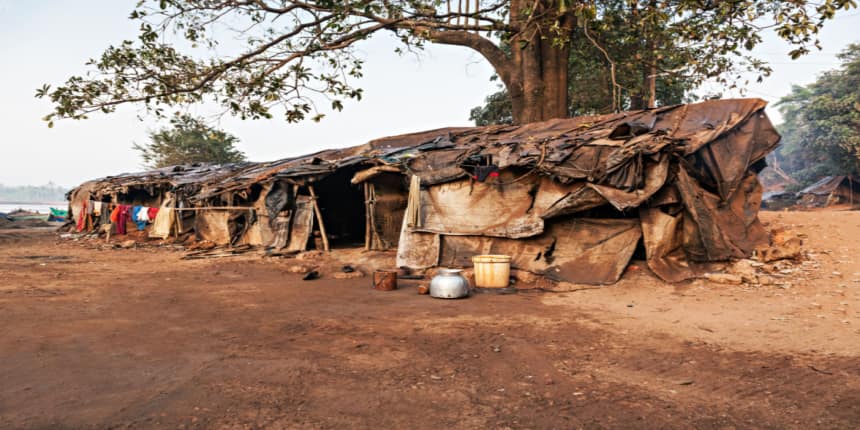ALLEN Coaching
ApplyRegister for ALLEN Scholarship Test & get up to 90% Scholarship
Poverty is a situation which refers to the condition when a person is not able to meet the basic needs for survival of his life. He cannot eat 3-time meals, wear clothes and afford shelter. In India, poverty has been a rampant problem for decades. Here are some sample speeches on the topic of Poverty In India.

Poverty is a significant issue in all the developing and underdeveloped countries of the world.
In India, 21 percent of the rural population and 5.5 per cent of the urban population live in poverty.
The leading cause of poverty in India is its vast population which could be managed more efficiently.
Apart from the population, India also needs to provide healthcare and education and housing facilities to its poor.
The backward class of society usually consists of the lower caste people, resulting from exploitation for centuries.
Various programs have been launched by the Centre and state governments to eradicate India's poverty.
Schemes like MNREGA and PM SHRI have been launched to provide employment and education to the poor.
Though the conditions are still unfortunate, India has seen a rapid decline in the poverty rate in the last decade.
Poverty is one of the primary reasons hindering India's status from becoming fully developed.
Only with continuous efforts from the government and Individuals can poverty be eradicated from our country.
Poverty is defined as a dire situation when one does not have enough means to sustain the necessities of his life. Even in developed countries, poverty is a miserable and colossal problem. However, in countries like Sri Lanka, South Africa, Uganda, Bangladesh and even India, which are underdeveloped and developing countries, the problem is rampant.
In India, poverty is more in the rural areas as the schemes launched by the government take a long time to penetrate the villages. There is also a need for more education in the villages as lack of education is a significant cause for this double-digit percentage. In the urban area, 5 percent of the population lives in poverty. The exponential population growth is also a big reason for poverty in India. The rapid increase in population leads to unemployment.
The government has launched many schemes aiming to remove poverty directly or indirectly. Schemes such as the Mahatma Gandhi National Rural Employment Guarantee Act ensured the right to work and provided labour to the unemployed. Mid-day meals and free schooling work well towards educating kids so that they can bring out their families from poverty. These schemes are working as in the last 15 years, and millions of people have came out of poverty in India.
When an individual fails to meet the basic needs of survival, he is unable to feed himself three proper meals, and he cannot afford food or shelter; he is said to be living in poverty.
Poverty has been a persistent problem in the modern world. Almost every country faces it and struggles to uplift the poor of its society. From homeless people in New York City to Slums in Dharavi, Mumbai - poverty has found its prey everywhere.
The problem of poverty is primarily faced in rural areas where there is a lack of education and a decrease in employment due to modern machinery. South Asian and African countries are the ones struggling the most with poverty.
Three Primary Reasons For Poverty In India.
Overpopulation | Lack of family planning leads to over 5-6 kids, especially in low-income families. Managing even the basic needs of those children pushes the family into poverty. Controlling overpopulation is a primary need of India.
Lack of Education | Due to lack of education, the poor population never indeed became aware of the existing government schemes and policies for them. They are also reluctant to send their wards to school since they have never been there and occupy them with menial tasks.
Corruption | Many government schemes don't even reach the grassroots level because of rampant corruption. Politicians and officials eat up the funds for infrastructure development and schools, leaving poor citizens suffering in poverty.
Though the government of India has been trying to curb poverty for decades through various policies and measures, it is still a significant concern and hurdle for our development. The Indian constitution has guaranteed all its citizens the right to work and education—two essential things to eradicate poverty from a grassroots level.
A few days ago, I joined an NGO which serves in the slums. I experienced what it is to live in poverty first-hand. The people in the slum were living in plastic tents. I couldn't imagine how they managed in rainy seasons. However, I was glad to see that their children went to the free government school and could easily do basic maths sums and English grammar problems.
We distributed parathas among them, which were sourced from a restaurant. They relished it and thanked us. We also asked about the problems they were facing and made a list. The NGO has planned to send a letter to government officials to address the issue and take necessary actions. It was an eye-opening experience for me, and I really wish that these people get their own homes soon.
In conclusion, the plans are gradually becoming successful as we have seen a decline in poverty rates in India in the last 15 years. If everything goes on as it is, India will eradicate poverty by 2030. Though still, plans and efforts are required at both individual and government levels.

Register for ALLEN Scholarship Test & get up to 90% Scholarship

Get up to 90% Scholarship on Offline NEET/JEE coaching from top Institutes

This ebook serves as a valuable study guide for NEET 2025 exam.

This e-book offers NEET PYQ and serves as an indispensable NEET study material.
As per latest 2024 syllabus. Physics formulas, equations, & laws of class 11 & 12th chapters
As per latest 2024 syllabus. Chemistry formulas, equations, & laws of class 11 & 12th chapters